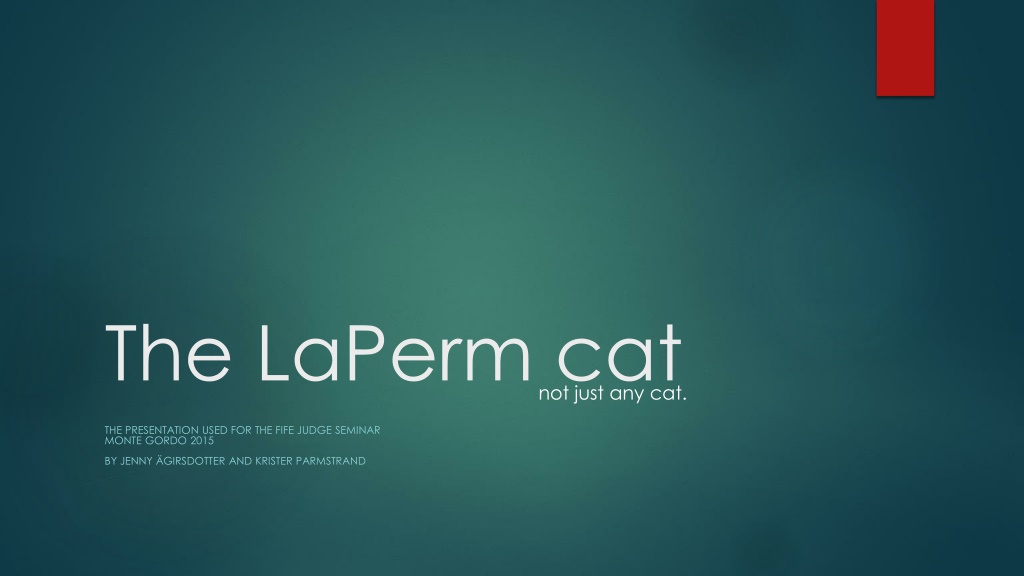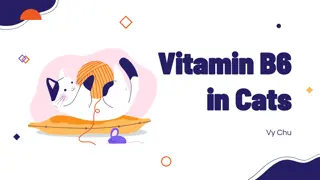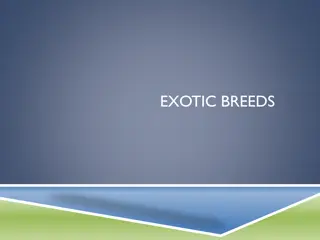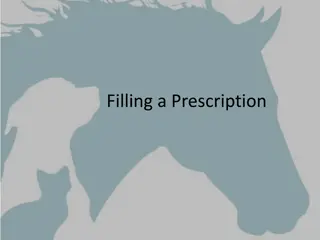The LaPerm Cat: A Unique Feline Breed
The LaPerm cat is a distinctive breed known for its curly coat, originating from barn cats in Oregon in the 1980s due to a spontaneous mutation. It comes in both longhair and shorthair varieties, with all coat and eye colors accepted. This medium-sized cat has a modified wedge-shaped head, high cheekbones, and long flexible whiskers.
Download Presentation

Please find below an Image/Link to download the presentation.
The content on the website is provided AS IS for your information and personal use only. It may not be sold, licensed, or shared on other websites without obtaining consent from the author.If you encounter any issues during the download, it is possible that the publisher has removed the file from their server.
You are allowed to download the files provided on this website for personal or commercial use, subject to the condition that they are used lawfully. All files are the property of their respective owners.
The content on the website is provided AS IS for your information and personal use only. It may not be sold, licensed, or shared on other websites without obtaining consent from the author.
E N D
Presentation Transcript
The LaPerm cat not just any cat. THE PRESENTATION USED FOR THE FIFE JUDGE SEMINAR MONTE GORDO 2015 BY JENNY GIRSDOTTER AND KRISTER PARMSTRAND
Origin Early 1980 s Barn cats in Oregon, USA Spontaneous mutation Dominant gene Bred freely for a decade Diverse genetic background
Standards LPL LaPerm Longhair LPS LaPerm Shorthair
General The LaPerm is a natural mutation producing a curly coat in both longhaired (LPL) and shorthaired (LPS) cats. It is medium sized cat with moderate type. All coat colours and eye colours are accepted. All parts of the body are in harmony with the size of the cat. The cat is alert and seems to be walking tall on its feet
Head Shape/size A modified wedge with gentle contours. Slightly longer than broad.
Head Forehead/top Forehead should be an almost flat plane.
Head Profile/nose Straight broad nose of medium length. In profile shows a slight indention, but without a stop.
Head Cheeks High cheek bones with gentle contours following the wedge shape.
Head Muzzle/Jaws Slightly broad muzzle in proportion to wedge.
Head Chin Firm chin in line with the tip of the nose.
Head Whiskers Long flexible whiskers. May be curved, wavy or straight. Whisker pads should appear full and rounded.
Head Ears Size:Medium to large Shape: Wide at base with slightly rounded tips. Full furnishing and lynx tipping is preferred on LPL but not required on LPS. Placement: Placed to continue the modified wedge of the head.
Head Eyes Size:Fairly large and expressive. Shape: Almond shape. Placement: Set well apart and slightly slanted toward base of ear. Colour: Every eye colour is accepted and does not have to relate to coat colour.
Body Size:Medium. Shape: A moderately elegant body. Hips are slightly higher than shoulders. Balanced and in proportion. Muscle/bones: Medium boning and well muscled. Neck: Medium long, in proportion to body
Body Torso/Chest: Medium in size. Length about one and half times height at shoulder. Medium depth of chest and flank. Legs/paws: Medium long to match body length. Medium boning, with rounded paws.
Body Tail Length:At least as long as to the shoulders, preferable to the neck. Shape: Tapering from base to tip. Furnishing: LPS - covered in curly hair, looks like a bottle brush. LPL - plumed with curly hair.
Coat Length:LPS - short. LPL - semi long. Texture/quality: Curls and waves all over. The coat should be loose and bouncy - a coat you can run your fingers through to the skin. It is springy, light and airy enough to part with a breath. Tightest curls in the ruff and the base of the ears. Contains all hair layers A mixture of softness and a hint of crisp wirehair. LPS - texture may be harder than on longhairs. LPL - coat shall have an almost unkempt appearance.
Coat Pattern:All patterns allowed Colour: All colour varieties are permitted, divided into 11 colour variety groups
Remarks The softness of the coat may vary among individuals and gender. Characteristic for the La Perm is the non seasonal molting, which can be general or partial, leaving the cat with temporarily sparse coat or semi-bald patches. This breed matures in 2-3 years. Allowances should be made for age and sex, on sparse coat and short/broken whiskers in kittens. There is a gender difference regarding head type - males generally have significantly broader heads which changes the proportions, making the head appear shorter.
Remarks Faults precluding certificate: Bald patches and/or too sparse coat in mature cats. Faults leading to disqualification: Straight hair. Cobby and short type Sia/oriental type.
Points Head Size/shape/muzzle/chin/profile Ears Eyes Total 35 15 10 10 Body Torso/neck Legs/feet Tail Total 30 10 10 10 shape, size, structure shape, size, structure shape, length Coat Texture and curls/waves Length Total 30 20 10 Condition 5






























